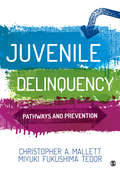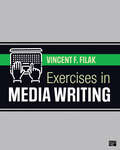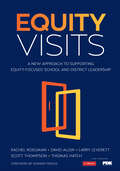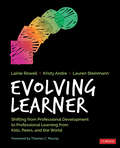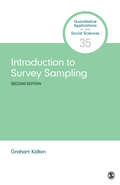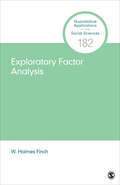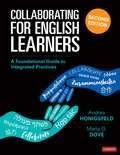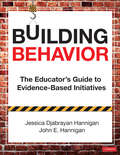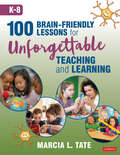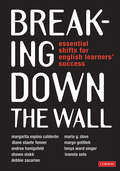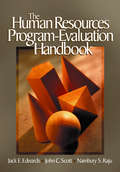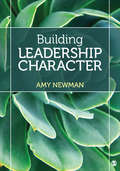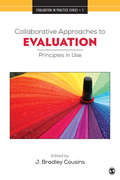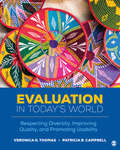- Table View
- List View
Juvenile Delinquency: Pathways and Prevention
by Christopher A. Mallett Miyuki Fukushima Tedor"This textbook is an excellent tool that explores issues impacting juvenile delinquency, theories, system response, community interventions, and effective programs to help reduce delinquency." —Robbin Day Brooks, MSW, CPP, Arizona State University’s School of Criminology & Criminal Justice Juvenile Delinquency: Pathways and Prevention explores the pivotal roles that family, trauma, mental health, and schools have on juvenile delinquency, while exploring opportunities for prevention and intervention. Authors Christopher A. Mallett and Miyuki Fukushima Tedor draw from years of experience working with juvenile offenders to shed light on the nature of delinquency and the diverse pathways to juvenile delinquency, while offering evidence-based techniques for preventing and rehabilitating youthful offenders. Clear explanations of the concepts and thought-provoking case studies move students beyond memorization—encouraging them to think critically about juvenile delinquency and make recommendations for better practices and policies. Give your students the SAGE edge! SAGE edge offers a robust online environment featuring an impressive array of free tools and resources for review, study, and further exploration, keeping both instructors and students on the cutting edge of teaching and learning.
Exercises in Media Writing
by Vincent F. FilakExercises in Media Writing offers students multiple opportunities to practice their writing skills in-class or as take-home assignments. Each chapter includes review questions and writing-prompt activities to help students master the concepts and skills presented in Vincent F. Filak’s second edition of Dynamics of Media Writing. Additional exercises built around the unique demands of online newswriting will prepare students to meet the demands of a changing media landscape. Key Features: Review Questions help students recall and master core chapter concepts Writing Exercises enable students to recall and demonstrate their understanding of various elements found in each chapter in Dynamics of Media Writing, Second Edition. Bundle this workbook with Dynamics of Media Writing and save! Your students save when you bundle this text with a corresponding student workbook. Order using bundle ISBN 9781544361970.
Exercises in Media Writing
by Vincent F. FilakExercises in Media Writing offers students multiple opportunities to practice their writing skills in-class or as take-home assignments. Each chapter includes review questions and writing-prompt activities to help students master the concepts and skills presented in Vincent F. Filak’s second edition of Dynamics of Media Writing. Additional exercises built around the unique demands of online newswriting will prepare students to meet the demands of a changing media landscape. Key Features: Review Questions help students recall and master core chapter concepts Writing Exercises enable students to recall and demonstrate their understanding of various elements found in each chapter in Dynamics of Media Writing, Second Edition. Bundle this workbook with Dynamics of Media Writing and save! Your students save when you bundle this text with a corresponding student workbook. Order using bundle ISBN 9781544361970.
Equity Visits: A New Approach to Supporting Equity-Focused School and District Leadership
by David Allen Larry Leverett Scott T. Thompson Thomas C. Hatch Rachel D. RoegmanBecause equity and instruction are inextricably bound Why are equity visits such a critical first step to increasing opportunity and access for our under-served students? Because they take instructional rounds to a new level, providing a powerful lens for investigating the intersections of equity and instruction. After all, how can we possibly deliver equitable learning experiences, opportunities, and outcomes for our students, without first pinpointing problems of practice? That’s where Equity Visits will prove absolutely indispensable to district and school administrators. It details how to combine a strong focus on instruction with explicit, intentional efforts to address systemic inequities. Inside you’ll find A range of data collection activities and tools to target central issues of equity in your school Clear guidelines on how to investigate the ways instructional practices, structures, and beliefs lead to inequitable educational experiences—and how these are often masked in the day-to-day life of schools and districts A frank discussion of how to make race and racism an explicit part of investigating and addressing educational inequities Voices of school and district leaders who have taken crucial first steps to become "equity warriors" Recommendations on how to develop policies, initiatives, and practices to confront those inequities Few dispute that instructional improvement must be a central focus of educational leadership, but for too long achieving educational equity has been absent from the conversation. Here is your opportunity to ensure equity occupy a central spot in data collection and analysis, and be explicitly discussed at all levels of your school or district organization. In short, essential reading and doing for all administrators!
Equity Visits: A New Approach to Supporting Equity-Focused School and District Leadership
by David Allen Larry Leverett Scott T. Thompson Thomas C. Hatch Rachel D. RoegmanBecause equity and instruction are inextricably bound Why are equity visits such a critical first step to increasing opportunity and access for our under-served students? Because they take instructional rounds to a new level, providing a powerful lens for investigating the intersections of equity and instruction. After all, how can we possibly deliver equitable learning experiences, opportunities, and outcomes for our students, without first pinpointing problems of practice? That’s where Equity Visits will prove absolutely indispensable to district and school administrators. It details how to combine a strong focus on instruction with explicit, intentional efforts to address systemic inequities. Inside you’ll find A range of data collection activities and tools to target central issues of equity in your school Clear guidelines on how to investigate the ways instructional practices, structures, and beliefs lead to inequitable educational experiences—and how these are often masked in the day-to-day life of schools and districts A frank discussion of how to make race and racism an explicit part of investigating and addressing educational inequities Voices of school and district leaders who have taken crucial first steps to become "equity warriors" Recommendations on how to develop policies, initiatives, and practices to confront those inequities Few dispute that instructional improvement must be a central focus of educational leadership, but for too long achieving educational equity has been absent from the conversation. Here is your opportunity to ensure equity occupy a central spot in data collection and analysis, and be explicitly discussed at all levels of your school or district organization. In short, essential reading and doing for all administrators!
Evolving Learner: Shifting From Professional Development to Professional Learning From Kids, Peers, and the World
by Lainie Jae Rowell Kristy J. Andre Lauren SteinmannLearn from Kids, Peers, and the World to Transform Professional Learning What can kids teach us about educational practices? It turns out, plenty. PD is evolving into professional learning (PL), where personalized experiences focus on goals and outcomes, rather than seat time. In Evolving Learner, successful PL is framed through three critical sources: learning from kids, from peers, and from the world. Woven throughout the book are tangible connections to cycles of inquiry where a harmonious balance is the ultimate goal when students are engaged in inquiry for deeper learning and teachers are engaged in a parallel process to improve their practice. The authors’ unique framework shifts away from factory model "PD" and transforms it into experiences tailored to kids’ and adult learners’ specific needs. Clear strategies for accomplishing PL are presented through A framework where both students and teachers are active agents of learning Cycles of inquiry to empower students to become the owners of learning Techniques to make thinking visible for teachers and students Cutting edge coverage of applying technology to professional learning including the use of social media, gamification, and digital badges The time is right to reclaim ownership of your professional learning: Evolving Learner is an essential guide for embarking on this journey.
Evolving Learner: Shifting From Professional Development to Professional Learning From Kids, Peers, and the World
by Lainie Jae Rowell Kristy J. Andre Lauren SteinmannLearn from Kids, Peers, and the World to Transform Professional Learning What can kids teach us about educational practices? It turns out, plenty. PD is evolving into professional learning (PL), where personalized experiences focus on goals and outcomes, rather than seat time. In Evolving Learner, successful PL is framed through three critical sources: learning from kids, from peers, and from the world. Woven throughout the book are tangible connections to cycles of inquiry where a harmonious balance is the ultimate goal when students are engaged in inquiry for deeper learning and teachers are engaged in a parallel process to improve their practice. The authors’ unique framework shifts away from factory model "PD" and transforms it into experiences tailored to kids’ and adult learners’ specific needs. Clear strategies for accomplishing PL are presented through A framework where both students and teachers are active agents of learning Cycles of inquiry to empower students to become the owners of learning Techniques to make thinking visible for teachers and students Cutting edge coverage of applying technology to professional learning including the use of social media, gamification, and digital badges The time is right to reclaim ownership of your professional learning: Evolving Learner is an essential guide for embarking on this journey.
Introduction to Survey Sampling (Quantitative Applications in the Social Sciences #35)
by Graham KaltonSample design is key to all surveys, fundamental to data collection, and to the analysis and interpretation of the data. Introduction to Survey Sampling, Second Edition provides an authoritative and accessible source on sample design strategies and procedures that is a required reading for anyone collecting or analyzing survey data. Graham Kalton discusses different types of probability samples, stratification (pre and post), clustering, dual frames, replicates, response, base weights, design effects, and effective sample size. It is a thorough revision and update of the first edition, published more than 35 years ago. Although the concepts of probability sampling are largely the same, there have been important developments in the application of these concepts as research questions have increasingly spanned multiple disciplines, computers have become central to data collection as well as data analysis, and cell phones have become ubiquitous, but response rates have fallen, and public willingness to engage in survey research has waned. While most of the volume focuses on probability samples, there is also a chapter on nonprobability samples, which are becoming increasingly important with the rise of social media and the world wide web.
Introduction to Survey Sampling (Quantitative Applications in the Social Sciences #35)
by Graham KaltonSample design is key to all surveys, fundamental to data collection, and to the analysis and interpretation of the data. Introduction to Survey Sampling, Second Edition provides an authoritative and accessible source on sample design strategies and procedures that is a required reading for anyone collecting or analyzing survey data. Graham Kalton discusses different types of probability samples, stratification (pre and post), clustering, dual frames, replicates, response, base weights, design effects, and effective sample size. It is a thorough revision and update of the first edition, published more than 35 years ago. Although the concepts of probability sampling are largely the same, there have been important developments in the application of these concepts as research questions have increasingly spanned multiple disciplines, computers have become central to data collection as well as data analysis, and cell phones have become ubiquitous, but response rates have fallen, and public willingness to engage in survey research has waned. While most of the volume focuses on probability samples, there is also a chapter on nonprobability samples, which are becoming increasingly important with the rise of social media and the world wide web.
Exploratory Factor Analysis (Quantitative Applications in the Social Sciences #182)
by Holmes FinchA firm knowledge of factor analysis is key to understanding much published research in the social and behavioral sciences. Exploratory Factor Analysis by W. Holmes Finch provides a solid foundation in exploratory factor analysis (EFA), which along with confirmatory factor analysis, represents one of the two major strands in this field. The book lays out the mathematical foundations of EFA; explores the range of methods for extracting the initial factor structure; explains factor rotation; and outlines the methods for determining the number of factors to retain in EFA. The concluding chapter addresses a number of other key issues in EFA, such as determining the appropriate sample size for a given research problem, and the handling of missing data. It also offers brief introductions to exploratory structural equation modeling, and multilevel models for EFA. Example computer code, and the annotated output for all of the examples included in the text are available on an accompanying website.
Exploratory Factor Analysis (Quantitative Applications in the Social Sciences #182)
by Holmes FinchA firm knowledge of factor analysis is key to understanding much published research in the social and behavioral sciences. Exploratory Factor Analysis by W. Holmes Finch provides a solid foundation in exploratory factor analysis (EFA), which along with confirmatory factor analysis, represents one of the two major strands in this field. The book lays out the mathematical foundations of EFA; explores the range of methods for extracting the initial factor structure; explains factor rotation; and outlines the methods for determining the number of factors to retain in EFA. The concluding chapter addresses a number of other key issues in EFA, such as determining the appropriate sample size for a given research problem, and the handling of missing data. It also offers brief introductions to exploratory structural equation modeling, and multilevel models for EFA. Example computer code, and the annotated output for all of the examples included in the text are available on an accompanying website.
Collaborating for English Learners: A Foundational Guide to Integrated Practices
by Maria G. Dove Andrea HonigsfeldLooking for a silver bullet to accelerate EL achievement? There is none. But this, we promise: when EL specialists and general ed teachers pool their expertise, your ELs’ language development and content mastery will improve exponentially. Just ask the tens of thousands of Collaboration and Co-Teaching users and now, a new generation of educators, thanks to this all-new second edition: Collaborating for English Learners. Why this new edition? Because more than a decade of implementation has generated for Andrea Honigsfeld and Maria Dove new insight into what exemplary teacher collaboration looks like, which essential frameworks must be established, and how integrated approaches to ELD services benefit all stakeholders. Essentially a roadmap to the many different ways we can all work together, this second edition of Collaborating for English Learners features: All-new examples, case studies, illustrative video, and policy updates In-depth coverage of the full range of strategies and configurations for determining the best model to adopt Templates, planning guides, and other practical tools to put collaboration into practice Guidelines, self-assessments, and questionnaires for evaluating the strategies’ effectiveness By this time, the big benefits of teacher collaboration are well documented. Where teachers and schools struggle still is determining the best way to do so, especially when working with our ELs. That’s where Andrea Honigsfeld, Maria Dove, and their second edition of Collaborating for English Learners will prove absolutely indispensable. After all, there are no two better authorities.
Collaborating for English Learners: A Foundational Guide to Integrated Practices
by Maria G. Dove Andrea HonigsfeldLooking for a silver bullet to accelerate EL achievement? There is none. But this, we promise: when EL specialists and general ed teachers pool their expertise, your ELs’ language development and content mastery will improve exponentially. Just ask the tens of thousands of Collaboration and Co-Teaching users and now, a new generation of educators, thanks to this all-new second edition: Collaborating for English Learners. Why this new edition? Because more than a decade of implementation has generated for Andrea Honigsfeld and Maria Dove new insight into what exemplary teacher collaboration looks like, which essential frameworks must be established, and how integrated approaches to ELD services benefit all stakeholders. Essentially a roadmap to the many different ways we can all work together, this second edition of Collaborating for English Learners features: All-new examples, case studies, illustrative video, and policy updates In-depth coverage of the full range of strategies and configurations for determining the best model to adopt Templates, planning guides, and other practical tools to put collaboration into practice Guidelines, self-assessments, and questionnaires for evaluating the strategies’ effectiveness By this time, the big benefits of teacher collaboration are well documented. Where teachers and schools struggle still is determining the best way to do so, especially when working with our ELs. That’s where Andrea Honigsfeld, Maria Dove, and their second edition of Collaborating for English Learners will prove absolutely indispensable. After all, there are no two better authorities.
Building Behavior: The Educator′s Guide to Evidence-Based Initiatives
by John E. Hannigan Jessica Djabrayan HanniganBuild the behavior system your students need and deserve Students deserve a safe, welcoming, and tolerant learning environment in which high expectations for academic and social/emotional learning will flourish. To achieve this, schools must implement consistent behavior initiatives that are rooted in equity and clear in outcome and purpose. Which plan is best for your students’ needs? In Building Behavior, authors Jessica Djabrayan Hannigan and John Hannigan identify the strengths of six major research-based behavior initiatives and offer practical guidance for implementing one or more that meet the unique needs of your students and school. They explore and connect the relationship of effect sizes and influence of six common behavior initiatives—Positive Behavior Interventions and Supports, Character Education, Restorative Justice, Culturally Responsive Teaching, Trauma Informed Practices, and Social and Emotional Learning—to help educators understand the purpose of each and give school leaders a starting point for adding to, refining, or building a tailored behavior system that is effective and manageable. Building Behavior includes: Common definitions, frameworks, best practice resources, and tips for implementing and synthesizing each of the behavior initiatives Reflective prompts that connect the existing body of knowledge with real life experiences and practices Reproducible resources, including sample schoolwide and district-wide assessments Tips to avoid common implementation challenges and missteps Don’t just reach for the "next best thing." Learn to select, self-assess, and build a plan for effective implementation of a behavior system that meets the diverse academic and social/emotional learning needs of your students. "This book offers comprehensive, unbiased information on effective behavior initiatives and provides effective tools for implementing the action plan that best fits a school. It provides a one-stop shop that educators can use to evaluate their current behavior plan, research the most current behavior initiatives, and tailor-fit an initiative for their school." - Mandy White, Science Teacher, Vicenza Middle School, U.S. Department of Defense Education Activity
Building Behavior: The Educator′s Guide to Evidence-Based Initiatives
by John E. Hannigan Jessica Djabrayan HanniganBuild the behavior system your students need and deserve Students deserve a safe, welcoming, and tolerant learning environment in which high expectations for academic and social/emotional learning will flourish. To achieve this, schools must implement consistent behavior initiatives that are rooted in equity and clear in outcome and purpose. Which plan is best for your students’ needs? In Building Behavior, authors Jessica Djabrayan Hannigan and John Hannigan identify the strengths of six major research-based behavior initiatives and offer practical guidance for implementing one or more that meet the unique needs of your students and school. They explore and connect the relationship of effect sizes and influence of six common behavior initiatives—Positive Behavior Interventions and Supports, Character Education, Restorative Justice, Culturally Responsive Teaching, Trauma Informed Practices, and Social and Emotional Learning—to help educators understand the purpose of each and give school leaders a starting point for adding to, refining, or building a tailored behavior system that is effective and manageable. Building Behavior includes: Common definitions, frameworks, best practice resources, and tips for implementing and synthesizing each of the behavior initiatives Reflective prompts that connect the existing body of knowledge with real life experiences and practices Reproducible resources, including sample schoolwide and district-wide assessments Tips to avoid common implementation challenges and missteps Don’t just reach for the "next best thing." Learn to select, self-assess, and build a plan for effective implementation of a behavior system that meets the diverse academic and social/emotional learning needs of your students. "This book offers comprehensive, unbiased information on effective behavior initiatives and provides effective tools for implementing the action plan that best fits a school. It provides a one-stop shop that educators can use to evaluate their current behavior plan, research the most current behavior initiatives, and tailor-fit an initiative for their school." - Mandy White, Science Teacher, Vicenza Middle School, U.S. Department of Defense Education Activity
100 Brain-Friendly Lessons for Unforgettable Teaching and Learning (K-8)
by Marcia L. TateUse research- and brain-based teaching to engage students and maximize learning Lessons should be memorable and engaging. When they are, student achievement increases, behavior problems decrease, and teaching and learning are fun! In 100 Brain-Friendly Lessons for Unforgettable Teaching and Learning K-8, best-selling author and renowned educator and consultant Marcia Tate takes her bestselling Worksheets Don’t Grow Dendrites one step further by providing teachers with ready-to-use lesson plans that take advantage of the way that students really learn. Readers will find 100 cross-curricular sample lessons from each of the four major content areas: English/language arts, mathematics, science, and social studies. Plans designed around the most frequently taught objectives found in national and international curricula. Lessons educators can immediately replicate in their own classrooms or use to develop their own. 20 brain-compatible, research-based instructional strategies that work for all learners. Five questions that teachers should ask and answer when planning brain-compatible lessons and an in-depth explanation of each of the questions. Guidance on building relationships with students that enable them to learn at optimal levels. It is a wonderful time to be a teacher! This hands-on resource will show you how to use what we know about educational neuroscience to transform your classroom into a place where success if accessible for all.
100 Brain-Friendly Lessons for Unforgettable Teaching and Learning (K-8)
by Marcia L. TateUse research- and brain-based teaching to engage students and maximize learning Lessons should be memorable and engaging. When they are, student achievement increases, behavior problems decrease, and teaching and learning are fun! In 100 Brain-Friendly Lessons for Unforgettable Teaching and Learning K-8, best-selling author and renowned educator and consultant Marcia Tate takes her bestselling Worksheets Don’t Grow Dendrites one step further by providing teachers with ready-to-use lesson plans that take advantage of the way that students really learn. Readers will find 100 cross-curricular sample lessons from each of the four major content areas: English/language arts, mathematics, science, and social studies. Plans designed around the most frequently taught objectives found in national and international curricula. Lessons educators can immediately replicate in their own classrooms or use to develop their own. 20 brain-compatible, research-based instructional strategies that work for all learners. Five questions that teachers should ask and answer when planning brain-compatible lessons and an in-depth explanation of each of the questions. Guidance on building relationships with students that enable them to learn at optimal levels. It is a wonderful time to be a teacher! This hands-on resource will show you how to use what we know about educational neuroscience to transform your classroom into a place where success if accessible for all.
Breaking Down the Wall: Essential Shifts for English Learners’ Success
by Debbie Zacarian Maria G. Dove Margarita Espino Calderon Diane Staehr Fenner Tonya W. Singer Margo Gottlieb Ivannia Soto Shawn M. Sinclair-Slakk Andrea HonigsfeldIt was a dark and stormy night in Santa Barbara. January 19, 2017. The next day’s inauguration drumroll played on the evening news. Huddled around a table were nine Corwin authors and their publisher, who together have devoted their careers to equity in education. They couldn’t change the weather, they couldn’t heal a fractured country, but they did have the power to put their collective wisdom about EL education upon the page to ensure our multilingual learners reach their highest potential. Proudly, we introduce you now to the fruit of that effort: Breaking Down the Wall: Essential Shifts for English Learners’ Success. In this first-of-a-kind collaboration, teachers and leaders, whether in small towns or large urban centers, finally have both the research and the practical strategies to take those first steps toward excellence in educating our culturally and linguistically diverse children. It’s a book to be celebrated because it means we can throw away the dark glasses of deficit-based approaches and see children who come to school speaking a different home language for what they really are: learners with tremendous assets. The authors’ contributions are arranged in nine chapters that become nine tenets for teachers and administrators to use as calls to actions in their own efforts to realize our English learners’ potential: 1. From Deficit-Based to Asset-Based 2. From Compliance to Excellence 3. From Watering Down to Challenging 4. From Isolation to Collaboration 5. From Silence to Conversation 6. From Language to Language, Literacy, and Content 7. From Assessment of Learning to Assessment for and as Learning 8. From Monolingualism to Multilingualism 9. From Nobody Cares to Everyone/Every Community Cares Read this book; the chapters speak to one another, a melodic echo of expertise, classroom vignettes, and steps to take. To shift the status quo is neither fast nor easy, but there is a clear process, and it’s laid out here in Breaking Down the Wall. To distill it into a single line would go something like this: if we can assume mutual ownership, if we can connect instruction to all children’s personal, social, cultural, and linguistic identities, then all students will achieve.
Breaking Down the Wall: Essential Shifts for English Learners’ Success
by Debbie Zacarian Maria G. Dove Margarita Espino Calderon Diane Staehr Fenner Tonya W. Singer Margo Gottlieb Ivannia Soto Shawn M. Sinclair-Slakk Andrea HonigsfeldIt was a dark and stormy night in Santa Barbara. January 19, 2017. The next day’s inauguration drumroll played on the evening news. Huddled around a table were nine Corwin authors and their publisher, who together have devoted their careers to equity in education. They couldn’t change the weather, they couldn’t heal a fractured country, but they did have the power to put their collective wisdom about EL education upon the page to ensure our multilingual learners reach their highest potential. Proudly, we introduce you now to the fruit of that effort: Breaking Down the Wall: Essential Shifts for English Learners’ Success. In this first-of-a-kind collaboration, teachers and leaders, whether in small towns or large urban centers, finally have both the research and the practical strategies to take those first steps toward excellence in educating our culturally and linguistically diverse children. It’s a book to be celebrated because it means we can throw away the dark glasses of deficit-based approaches and see children who come to school speaking a different home language for what they really are: learners with tremendous assets. The authors’ contributions are arranged in nine chapters that become nine tenets for teachers and administrators to use as calls to actions in their own efforts to realize our English learners’ potential: 1. From Deficit-Based to Asset-Based 2. From Compliance to Excellence 3. From Watering Down to Challenging 4. From Isolation to Collaboration 5. From Silence to Conversation 6. From Language to Language, Literacy, and Content 7. From Assessment of Learning to Assessment for and as Learning 8. From Monolingualism to Multilingualism 9. From Nobody Cares to Everyone/Every Community Cares Read this book; the chapters speak to one another, a melodic echo of expertise, classroom vignettes, and steps to take. To shift the status quo is neither fast nor easy, but there is a clear process, and it’s laid out here in Breaking Down the Wall. To distill it into a single line would go something like this: if we can assume mutual ownership, if we can connect instruction to all children’s personal, social, cultural, and linguistic identities, then all students will achieve.
The Human Resources Program-Evaluation Handbook
by John C. Scott Nambury S. Raju Jack E. EdwardsTechnological advances and rapid changes in workforce demographics pose extensive challenges to human resources program evaluators. But little has been done to document successful human resources program assessment and implementation strategies. The Human Resources Program-Evaluation Handbook is the first book to present state-of-the-art procedures for evaluating and improving human resources programs. Editors Jack E. Edwards, John C. Scott, and Nambury S. Raju provide a user-friendly yet scientifically rigorous "how to" guide to organizational program-evaluation. Integrating perspectives from a variety of human resources and organizational behavior programs, a wide array of contributing professors, consultants, and governmental personnel successfully link scientific information to practical application. Offering authoritative guidance to both novice and experienced program evaluators, this unique guidebook includes New perspectives on organizational program-evaluation Methods to assess the efficiency of human resources programs Identification of potential pitfalls Real-life examples Additional references for program-evaluation best practices The Human Resources Program-Evaluation Handbook provide program-evaluation teams with content-specific guidance. Supplying useful and accurate evaluation techniques, the editors present a manual for enhancing the effectiveness and efficiency of most major types of human resources programs. Designed for academics and graduate students in industrial-organizational psychology, human resources management, and business, the handbook is also an essential resource for human resources professionals, consultants, and policy makers.
Building Leadership Character: Lessons In Authenticity And Credibility
by Amy NewmanExtending beyond traditional leadership books to offer readers a path for developing their own character, this compelling new text uses a storytelling approach and real-world cases to explore different dimensions of leadership character. With a clear, student-friendly writing style, bestselling author Amy Newman deftly captures various approaches in which corporations and people respond to situations in difficult times and learn from mistakes. Using real companies and situations, each chapter examines a leadership character dimension such as accountability, integrity, authenticity, and courage. Readers will learn to develop their own character, emotional intelligence, and leadership skills as they engage with assessments, reflection opportunities, and exercises.
Building Leadership Character: Lessons In Authenticity And Credibility
by Amy NewmanExtending beyond traditional leadership books to offer readers a path for developing their own character, this compelling new text uses a storytelling approach and real-world cases to explore different dimensions of leadership character. With a clear, student-friendly writing style, bestselling author Amy Newman deftly captures various approaches in which corporations and people respond to situations in difficult times and learn from mistakes. Using real companies and situations, each chapter examines a leadership character dimension such as accountability, integrity, authenticity, and courage. Readers will learn to develop their own character, emotional intelligence, and leadership skills as they engage with assessments, reflection opportunities, and exercises.
Collaborative Approaches to Evaluation: Principles in Use (Evaluation in Practice Series #3)
by J. Bradley CousinsEditor J. Bradley Cousins and colleagues meet the needs of evaluators seeking to implement collaborative and participatory approaches to evaluation in Collaborative Approaches to Evaluation: Principles in Use. Using a multi-phase empirical process to develop and validate a set of principles to guide collaborative approaches to evaluation, the book outlines the principles that the team developed, and then provides case studies of how these principles have been applied in practice. The case studies draw on programs globally in education, health, and community development. The book is an invaluable supplementary text for program evaluation courses where students’ projects are focused on more collaborative and participatory approaches, and it is an essential resource for practicing evaluators and those who commission program evaluations.
Collaborative Approaches to Evaluation: Principles in Use (Evaluation in Practice Series #3)
by J. Bradley CousinsEditor J. Bradley Cousins and colleagues meet the needs of evaluators seeking to implement collaborative and participatory approaches to evaluation in Collaborative Approaches to Evaluation: Principles in Use. Using a multi-phase empirical process to develop and validate a set of principles to guide collaborative approaches to evaluation, the book outlines the principles that the team developed, and then provides case studies of how these principles have been applied in practice. The case studies draw on programs globally in education, health, and community development. The book is an invaluable supplementary text for program evaluation courses where students’ projects are focused on more collaborative and participatory approaches, and it is an essential resource for practicing evaluators and those who commission program evaluations.
Evaluation in Today’s World: Respecting Diversity, Improving Quality, and Promoting Usability
by Veronica G. Thomas Patricia B. CampbellRecipient of a 2021 Most Promising New Textbook Award from the Textbook & Academic Authors Association (TAA) Evaluation in Today’s World: Respecting Diversity, Improving Quality, and Promoting Usability is a timely and comprehensive textbook that guides students, practitioners, and users of evaluations in understanding evaluation purposes, theories, methodologies, and challenges within today’s sociocultural and political context. Veronica G. Thomas and Patricia B. Campbell include discussions of evaluation history, frameworks, models, types, planning, and methods, through a social justice, diversity, and inclusive lens. The authors focus on ethics in diverse cultural contexts, help readers understand how social problems and programs get politicized and, sometimes, framed through a racialized lens, show how to engage stakeholders in the evaluation process, and communicate results in culturally appropriate ways. Included with this title: The password-protected Instructor Resource Site (formally known as SAGE Edge) offers access to all text-specific resources, including a test bank and editable, chapter-specific PowerPoint® slides.
